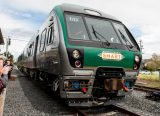Blog Post < Back to Search

SMART
SMART - When the Facts Don’t Fit the Climate Change Narrative
On October 21, I attended my first SMART train board meeting in Petaluma. The weekday afternoon scheduling makes it difficult for working citizens to attend, but none-the-less it attracted a handful of euphoric train supporters. When I spoke to oppose the train, the glances I received were as if I were the worst pariah – a climate change denier. It was like being an outsider attending a radical church - it was inconceivable that I could not be a believer.
As a high tech product manager, my success depends on questioning assertions and approaching decisions objectively. When I apply that skill set to SMART, scrutiny reveals the facts behind SMART just don’t fit the narrative.
After voters rejected SMART three times, SMART was finally approved in November 2008 based on measure Q that stated SMART would “fight global warming” and be an “environmentally responsible transportation alternative”.
Taken at face value, who could possibly oppose such a measure? The data reveals however that it is almost certain that SMART will increase emissions.
Many readers may be surprised to learn SMART is not electric nor a hybrid but a diesel train that gets 1.1mpg..
How do cars compare? Cars have become ever more fuel efficient, and by consuming less fuel consequently greenhouse gas emissions are reduced. Marin and Sonoma drivers are more environmentally aware – many drive hybrids and later model cars with lower emissions.
Taken at face value, official CO2 emissions figures from the California Air Resources Board suggest that SMART needs an average of 57 riders on every train to have an impact on reducing greenhouse gases.
This breakeven figure of 57 average riders assumes each and every SMART passenger was a former car driver. This is completely unrealistic. The American Public Transportation Association provides guidance that typically 42% of train riders are displaced car drivers. The implication is that in order not to increase greenhouse gas emissions SMART will need to average 137 riders per trip. Perhaps some might imagine that such a figure is achievable.
To put this in perspective, here is the average ridership per train of other mature rail systems based on operations reported to the Federal Transit Administration for the year 2013:
- -New Jersey Transit: 33.5 riders. This is for the River Line that runs through a densely populated corridors from Trenton to Philadelphia.
- -Tri County Oregon: 21.9 riders. While closer to Marin, one must remember that unlike SMART these trains are on an East to West line that directly serves the major employment center of Portland.
It stretches credibility to suggest SMART will achieve an average ridership of 137 by 2035, let alone by 2017. The only reasonable conclusion is that SMART will increase greenhouse gas emissions. This is Sonoma and Marin’s own Volkswagen crisis – we’ve had the wool pulled over our eyes with false claims of fighting climate change.
We need to get beyond the stigma that all transit projects must be green. Voters, board members and environmentalists alike need to scrutinize the facts behind projects claiming to be green before applying support.
Attending the SMART Board meeting gives me pause for concern. Despite low ridership, despite not reducing greenhouse gas emissions, and despite not solving our traffic problem, I can imagine SMART returning to voters with outstretched hands. They will have the audacity to say, “We’ve come so far, but we need more money to complete this project. Vote ‘yes’ on this ¼ cent ballot measure.” We must be careful not to be duped again and buy into this boondoggle in the name of fighting climate change.
Richard Hall is a resident of San Rafael and a high tech product manager who has worked for Netscape, Dolby and Sony. He led the successful opposition to the high-density housing planned around Civic Center Station in San Rafael that was part of the so-called SMART “Station Area Plan”.
